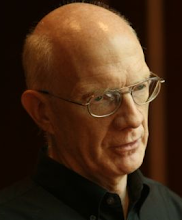There was recently, in the New York Times, a paean to the tailfin as promulgated by Detroit in the 1950's. In it, there was a brief excerpt from a
Robert Lowell poem. Lowell (for those of you who are, like me, generally ignorant of higher culture (especially poetry), Lowell was appointed the sixth Poet Laureate Consultant in Poetry to the Library of Congress (aka "Poet Laureate" of the United States) in 1946. His family included the other poets
Amy Lowell and
James Russell Lowell.

Here's the poem. "For the Union Dead" was commissioned for and first read at the Boston Arts Festival in 1960. It was the title work of his next book of poetry, published in 1964. See if you can find the quatrain that caught my eye (and was quoted in the Times). (The link to the Times article is below the poem.)
WARNING: this poem uses the "N" word, although (to my mind) in an historic and not a racist way.
For the Union DeadRelinquunt Ommia Servare Rem Publicam.The old South Boston Aquarium stands
in a Sahara of snow now. Its broken windows are boarded.
The bronze weathervane cod has lost half its scales.
The airy tanks are dry.
Once my nose crawled like a snail on the glass;
my hand tingled to burst the bubbles
drifting from the noses of the crowded, compliant fish.
My hand draws back. I often sign still
for the dark downward and vegetating kingdom
of the fish and reptile. One morning last March,
I pressed against the new barbed and galvanized
fence on the Boston Common. Behind their cage,
yellow dinosaur steamshovels were grunting
as they cropped up tons of mush and grass
to gouge their underworld garage.
Parking spaces luxuriate like civic
sandpiles in the heart of Boston.
a girdle of orange, Puritan-pumpkin colored girders
braces the tingling Statehouse,
shaking over the excavations, as it faces Colonel Shaw
and his bell-cheeked Negro infantry
on St. Gaudens' shaking Civil War relief,
propped by a plank splint against the garage's earthquake.
Two months after marching through Boston,
half of the regiment was dead;
at the dedication,
William James could almost hear the bronze Negroes breathe.
Their monument sticks like a fishbone
in the city's throat.
Its Colonel is a lean
as a compass-needle.
He has an angry wrenlike vigilance,
a greyhound's gentle tautness;
he seems to wince at pleasure,
and suffocate for privacy.
He is out of bounds now. He rejoices in man's lovely,
peculiar power to choose life and die-
when he leads his black soldiers to death,
he cannot bend his back.
On a thousand small town New England greens
the old white churches hold their air
of sparse, sincere rebellion; frayed flags
quilt the graveyards of the Grand Army of the Republic
The stone statutes of the abstract Union Soldier
grow slimmer and younger each year-
wasp-waisted, they doze over muskets
and muse through their sideburns…
Shaw's father wanted no monument
except the ditch,
where his son's body was thrown
and lost with his "niggers."
The ditch is nearer.
There are no statutes for the last war here;
on Boylston Street, a commercial photograph
shows Hiroshima boiling
over a Mosler Safe, the "Rock of Ages"
that survived the blast. Space is nearer.
when I crouch to my television set,
the drained faces of Negro school-children rise like balloons.
Colonel Shaw
is riding on his bubble,
he waits
for the blessed break.
The Aquarium is gone. Everywhere,
giant finned cars nose forward like fish;
a savage servility
slides by on grease.
—Robert Lowell, 1960
(Link to the New York Times article is
here.)
 Let's get to a late-breaking item, though, and that is a quality bike available at a bargain—at least, if you are in the market for a practical "urban" bike (that is, I think, the new "third category", after "road" and "mountain".) I don't advertise on this blog, and this is not an ad, just a heads-up on a bike that I'd buy for myself if I needed an urban warrior.
Let's get to a late-breaking item, though, and that is a quality bike available at a bargain—at least, if you are in the market for a practical "urban" bike (that is, I think, the new "third category", after "road" and "mountain".) I don't advertise on this blog, and this is not an ad, just a heads-up on a bike that I'd buy for myself if I needed an urban warrior.
















